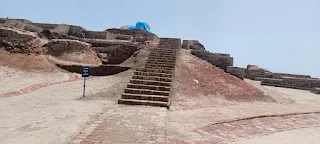The archaeological ruins at Mohenjo-daro can be a
fascinating exploration of one of the ancient world's most significant sites.
The Archaeological Ruins at Mohenjo-Daro
The ancient city of Mohenjo-Daro nestled along the banks of
the Indus River, is a testament to the advanced civilizations that thrived in
the Indian subcontinent over 4,000 years ago. In this blog, we journeyed
through time, unraveling the mysteries of the archaeological ruins at
Mohenjo-daro.
The Indus Valley Civilization:
Mohenjo-daro was a key city of the Indus Valley
Civilization, one of the world's earliest urban cultures. Flourishing between
2600 BCE, and1900 BCE this civilization
boasted remarkable achievements in city planning, architecture, and trade.
City Layout and Architecture of Mohenjo-Daro:
Urban Planning Marvels:
Mohenjo-Daro’s city layout is a testament to the advanced
urban planning of the Indus Valley Civilization. The city covered an impressive
250 acres and was divided into two main sections: the Citadel and the Lower
City.
Grid Pattern Streets:
The streets of Mohenjo-daro were laid out in a
well-organized grid pattern, suggesting careful planning and foresight. This
grid layout not only facilitated easy navigation but also showcased an
understanding of geometric principles.
Citadel and Lower City Distinction:
The Citadel, a raised area at the western end of the city,
housed some of the most significant structures. It was likely a fortified
administrative and religious center. The Lower City, sprawling over a larger
area, contained residential and commercial areas.
One of Mohenjo-Daro’s most iconic structures is the Great
Bath, located within the Citadel. This large, water-tight tank made from bricks
and tar is a masterpiece of ancient engineering. Its purpose remains a subject
of debate among historians and archaeologists.
Ritualistic or
Communal Use:
The Great Birth’s purpose is often speculated to be
ritualistic or communal bathing. The perfectly crafted brickwork, steps leading
into the tank, and a complex drainage system point to a sophisticated
understanding of hydraulics.
Multistoried Houses:
The residential areas of Mohenjo-daro reveal multistoried
houses made from standardized bricks. The consistent use of materials and
design elements suggests a planned approach to construction.
Indoor Plumbing:
Remarkably, some houses featured an advanced plumbing system
with interconnected drains and a network that allowed for the disposal of
waste. This demonstrates a level of urban sophistication rarely seen in ancient
civilizations.
Granaries:
The discovery of large granaries at Mohenjo-daro indicates a
well-organized system for food storage and distribution. These granaries were
strategically located, highlighting the importance of agriculture and trade in
the city.
Fortifications:
While Mohenjo-daro did not have large defensive walls like some
ancient cities, the layout of the city, with the Citadel situated on a raised
platform, suggests a degree of natural fortification. The careful placement of
structures may have been a strategic decision for defense.
Watchtowers:
Some scholars suggest that elevated structures within the
city, possibly watchtowers, served as observation points for monitoring the
surroundings and potential threats.
Urban Planning Marvels:
Mohenjo-Daro’s layout showcases an advanced urban planning
system. Streets were laid out in a grid pattern, and the city featured a
complex drainage system, suggesting a high level of engineering sophistication.
The Great Bath:
One of the most iconic structures at Mohenjo-daro is the
Great Bath. This large, rectangular tank hints at a communal or ritualistic
purpose, inviting speculation about the city's social and religious practices.
Residential Quarters:
Exploring the residential areas reveals multistoried houses
with well-defined rooms, indoor plumbing, and even evidence of a granary. The
layout suggests a society with a hierarchical structure and specialized urban
planning.
Artifacts and
Discoveries:
Seal Impressions:
Mohenjo-daro is renowned for its numerous seal impressions.
These intricate seals depict various animals and symbols, offering insights
into the civilization's script and possibly its trade connect
Figurines and Pottery:
Archaeologists have unearthed a plethora of figurines and
pottery, showcasing the craftsmanship and artistic flair of the people who once
inhabited the city. These artifacts provide clues about daily life, religious
beliefs, and cultural practices.
Decline and
Abandonment:
The enigma of Mohenjo-daro lies not only in its achievements
but also in its mysterious decline. Scholars debate the possible causes,
ranging from environmental changes to socio-political upheavals. The
abandonment of this once-thriving city adds an air of intrigue to its history.
Preservation
Challenges and Future Prospects:
Preservation Efforts:
Preserving Mohenjo-daro poses significant challenges due to
environmental factors, urbanization, and the sheer age of the site. Efforts by
archaeologists and conservationists aim to protect this invaluable heritage.
Visitor Experience:
Despite the challenges, Mohenjo-daro remains a destination
for history enthusiasts and curious minds. Visitors can explore the site's
remnants, marvel at the ancient urban planning, and contemplate the stories
embedded in the silent stones.
Conclusion:
Mohenjo-Daro’s
city layout and architecture provide a glimpse into the innovative and
organized mindset of the Indus Valley Civilization. The grid-based streets,
advanced drainage systems, and well-planned structures underscore the
sophisticated urban planning that was ahead of its time. As we explore the
remnants of this ancient city, we find ourselves in awe of the ingenuity that
shaped Mohenjo-daro into a thriving hub of civilization along the banks of the
mighty Indus River.
Mohenjo-daro stands as a captivating
window into the past, offering a glimpse of a sophisticated civilization that
thrived along the banks of the Indus River. As we navigate through its ruins,
we continue to unravel the mysteries of an ancient city that once echoed with
the hustle and bustle of daily life.









.jpg)








No comments:
Post a Comment